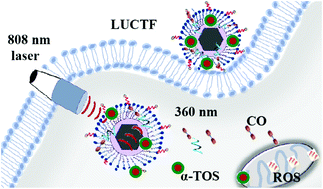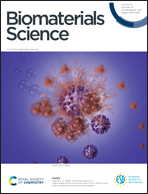Vitamin E-facilitated carbon monoxide pro-drug nanomedicine for efficient light-responsive combination cancer therapy†
Abstract
The quest to maximize therapeutic efficiency in cancer treatment requires innovative delivery nanoplatforms capable of employing different modules simultaneously. Combination therapy has proven to be one of the best anticancer strategies so far. Herein, we have developed a lipid-encapsulated nanoplatform that combines chemotherapy with photoresponsive gas therapy for colon cancer treatment. Carbon monoxide releasing molecules (CORMs) and vitamin E analogues (pure/pegylated α-tocopheryl succinate; α-TOS) were co-loaded into the lipid layer with core–shell upconversion nanoparticles (UCNPs), which converted 808 nm light to 360 nm photons to trigger CO release at the tumor site. This folic acid (FA)-targeting nanomedicine (Lipid/UCNP/CORM/α-TOS/FA: LUCTF) possessed a cancer-targeting ability and a light-triggered CO release ability for synergistic apoptosis of HCT116 cells via enhanced ROS generation and mitochondrial membrane breaking. In vivo data have confirmed the significantly enhanced therapeutic efficacy of LUCTF without any significant biosafety issues after intravenous administration. Thus, nanomedicine LUCTF represents a novel way for efficient cancer therapy via combining locally released CO and a compatible chemotherapeutic agent (e.g. α-TOS).



 Please wait while we load your content...
Please wait while we load your content...